A Comprehensive Analysis of Oil Supply and Demand in Australia
VerifiedAdded on 2020/03/04
|6
|1329
|62
Report
AI Summary
This report provides an in-depth analysis of the supply and demand dynamics of the oil market in Australia. It explores the country's unique position as both a producer and importer of oil, examining the interplay of domestic production, import levels, and consumption patterns. The analysis delves into the economic factors influencing oil prices, including global market trends, production costs, and government policies. The report highlights the impact of fluctuating oil prices on the Australian economy, including the challenges faced by domestic oil producers and the implications of over-reliance on imports. Furthermore, it discusses the influence of oligopolistic competition among oil producers and the shift towards renewable energy sources. The report concludes with recommendations for the Australian government, such as providing subsidies to local oil companies, reducing corporate taxes, and building oil storage facilities to mitigate the risks associated with price volatility. Ultimately, the report emphasizes the importance of government intervention to ensure the long-term sustainability of Australia's oil supply and protect the economy from the potential negative consequences of over-reliance on imports.
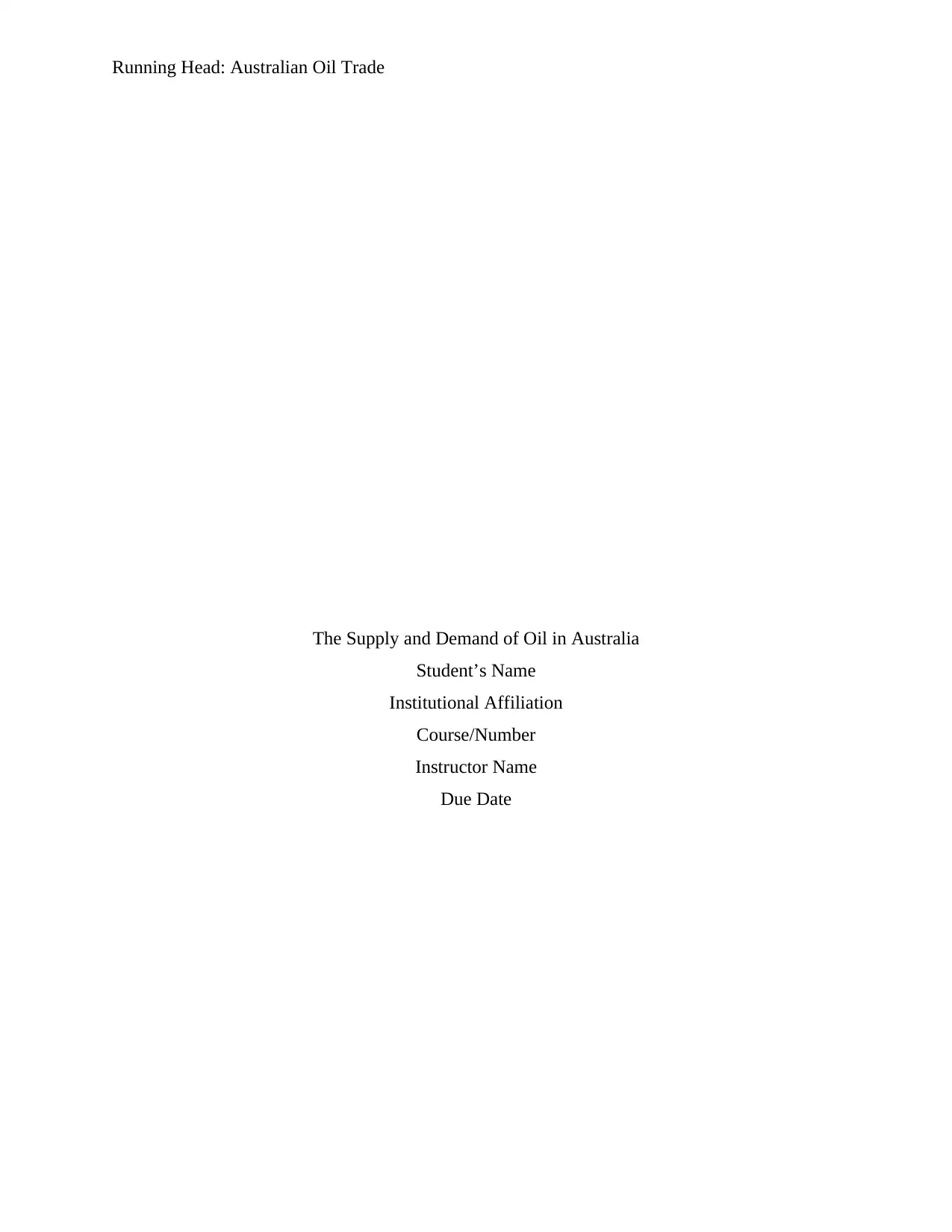
Running Head: Australian Oil Trade
The Supply and Demand of Oil in Australia
Student’s Name
Institutional Affiliation
Course/Number
Instructor Name
Due Date
The Supply and Demand of Oil in Australia
Student’s Name
Institutional Affiliation
Course/Number
Instructor Name
Due Date
Paraphrase This Document
Need a fresh take? Get an instant paraphrase of this document with our AI Paraphraser
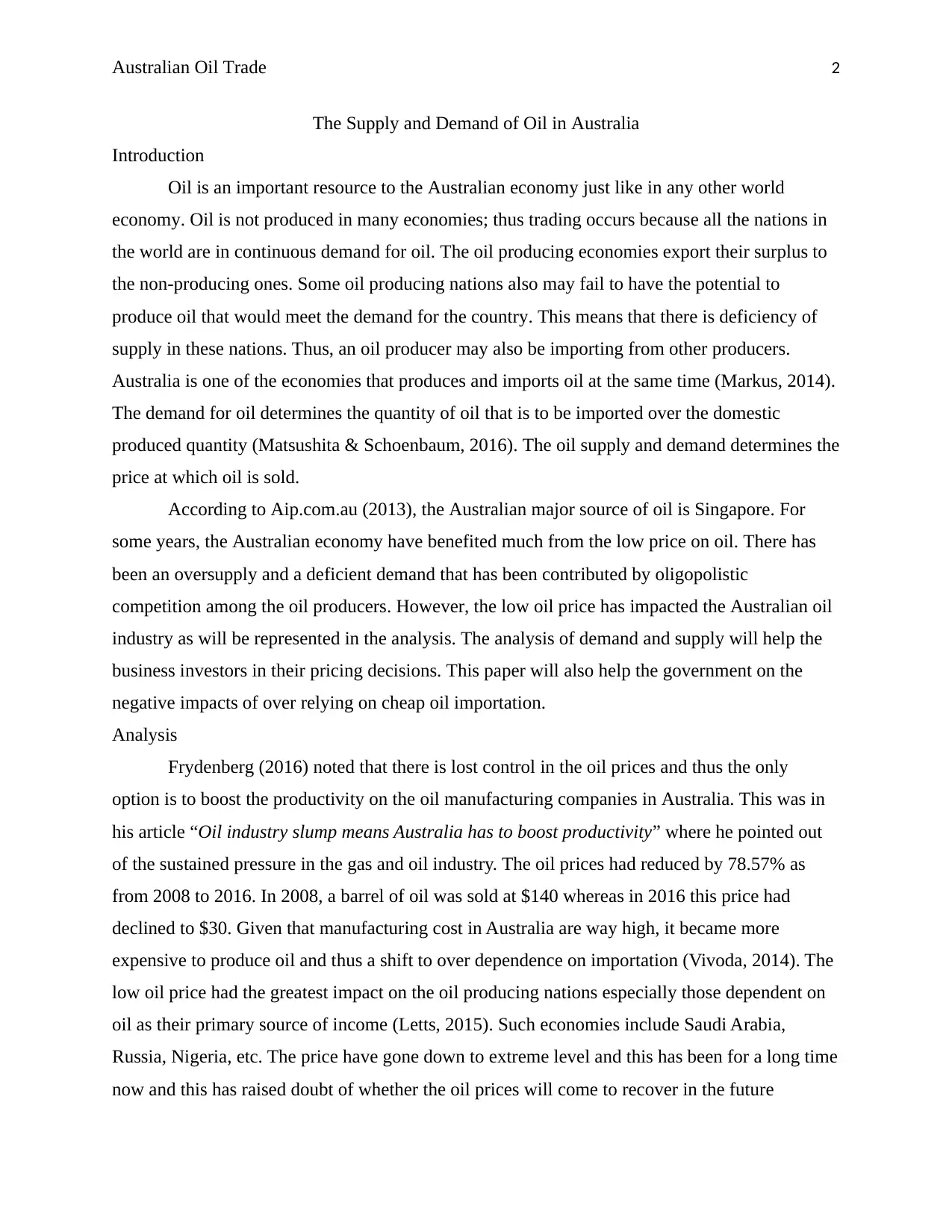
Australian Oil Trade 2
The Supply and Demand of Oil in Australia
Introduction
Oil is an important resource to the Australian economy just like in any other world
economy. Oil is not produced in many economies; thus trading occurs because all the nations in
the world are in continuous demand for oil. The oil producing economies export their surplus to
the non-producing ones. Some oil producing nations also may fail to have the potential to
produce oil that would meet the demand for the country. This means that there is deficiency of
supply in these nations. Thus, an oil producer may also be importing from other producers.
Australia is one of the economies that produces and imports oil at the same time (Markus, 2014).
The demand for oil determines the quantity of oil that is to be imported over the domestic
produced quantity (Matsushita & Schoenbaum, 2016). The oil supply and demand determines the
price at which oil is sold.
According to Aip.com.au (2013), the Australian major source of oil is Singapore. For
some years, the Australian economy have benefited much from the low price on oil. There has
been an oversupply and a deficient demand that has been contributed by oligopolistic
competition among the oil producers. However, the low oil price has impacted the Australian oil
industry as will be represented in the analysis. The analysis of demand and supply will help the
business investors in their pricing decisions. This paper will also help the government on the
negative impacts of over relying on cheap oil importation.
Analysis
Frydenberg (2016) noted that there is lost control in the oil prices and thus the only
option is to boost the productivity on the oil manufacturing companies in Australia. This was in
his article “Oil industry slump means Australia has to boost productivity” where he pointed out
of the sustained pressure in the gas and oil industry. The oil prices had reduced by 78.57% as
from 2008 to 2016. In 2008, a barrel of oil was sold at $140 whereas in 2016 this price had
declined to $30. Given that manufacturing cost in Australia are way high, it became more
expensive to produce oil and thus a shift to over dependence on importation (Vivoda, 2014). The
low oil price had the greatest impact on the oil producing nations especially those dependent on
oil as their primary source of income (Letts, 2015). Such economies include Saudi Arabia,
Russia, Nigeria, etc. The price have gone down to extreme level and this has been for a long time
now and this has raised doubt of whether the oil prices will come to recover in the future
The Supply and Demand of Oil in Australia
Introduction
Oil is an important resource to the Australian economy just like in any other world
economy. Oil is not produced in many economies; thus trading occurs because all the nations in
the world are in continuous demand for oil. The oil producing economies export their surplus to
the non-producing ones. Some oil producing nations also may fail to have the potential to
produce oil that would meet the demand for the country. This means that there is deficiency of
supply in these nations. Thus, an oil producer may also be importing from other producers.
Australia is one of the economies that produces and imports oil at the same time (Markus, 2014).
The demand for oil determines the quantity of oil that is to be imported over the domestic
produced quantity (Matsushita & Schoenbaum, 2016). The oil supply and demand determines the
price at which oil is sold.
According to Aip.com.au (2013), the Australian major source of oil is Singapore. For
some years, the Australian economy have benefited much from the low price on oil. There has
been an oversupply and a deficient demand that has been contributed by oligopolistic
competition among the oil producers. However, the low oil price has impacted the Australian oil
industry as will be represented in the analysis. The analysis of demand and supply will help the
business investors in their pricing decisions. This paper will also help the government on the
negative impacts of over relying on cheap oil importation.
Analysis
Frydenberg (2016) noted that there is lost control in the oil prices and thus the only
option is to boost the productivity on the oil manufacturing companies in Australia. This was in
his article “Oil industry slump means Australia has to boost productivity” where he pointed out
of the sustained pressure in the gas and oil industry. The oil prices had reduced by 78.57% as
from 2008 to 2016. In 2008, a barrel of oil was sold at $140 whereas in 2016 this price had
declined to $30. Given that manufacturing cost in Australia are way high, it became more
expensive to produce oil and thus a shift to over dependence on importation (Vivoda, 2014). The
low oil price had the greatest impact on the oil producing nations especially those dependent on
oil as their primary source of income (Letts, 2015). Such economies include Saudi Arabia,
Russia, Nigeria, etc. The price have gone down to extreme level and this has been for a long time
now and this has raised doubt of whether the oil prices will come to recover in the future
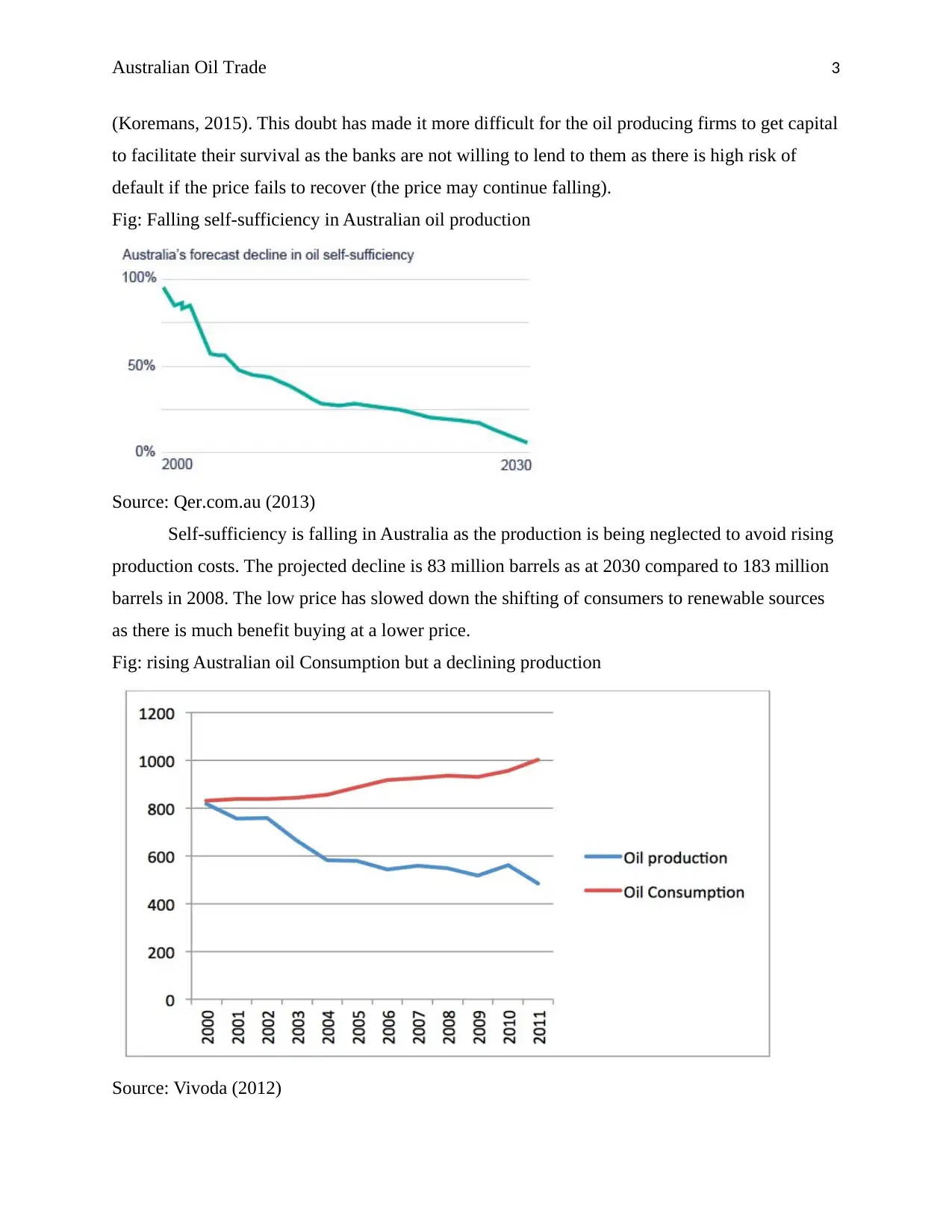
Australian Oil Trade 3
(Koremans, 2015). This doubt has made it more difficult for the oil producing firms to get capital
to facilitate their survival as the banks are not willing to lend to them as there is high risk of
default if the price fails to recover (the price may continue falling).
Fig: Falling self-sufficiency in Australian oil production
Source: Qer.com.au (2013)
Self-sufficiency is falling in Australia as the production is being neglected to avoid rising
production costs. The projected decline is 83 million barrels as at 2030 compared to 183 million
barrels in 2008. The low price has slowed down the shifting of consumers to renewable sources
as there is much benefit buying at a lower price.
Fig: rising Australian oil Consumption but a declining production
Source: Vivoda (2012)
(Koremans, 2015). This doubt has made it more difficult for the oil producing firms to get capital
to facilitate their survival as the banks are not willing to lend to them as there is high risk of
default if the price fails to recover (the price may continue falling).
Fig: Falling self-sufficiency in Australian oil production
Source: Qer.com.au (2013)
Self-sufficiency is falling in Australia as the production is being neglected to avoid rising
production costs. The projected decline is 83 million barrels as at 2030 compared to 183 million
barrels in 2008. The low price has slowed down the shifting of consumers to renewable sources
as there is much benefit buying at a lower price.
Fig: rising Australian oil Consumption but a declining production
Source: Vivoda (2012)
⊘ This is a preview!⊘
Do you want full access?
Subscribe today to unlock all pages.

Trusted by 1+ million students worldwide
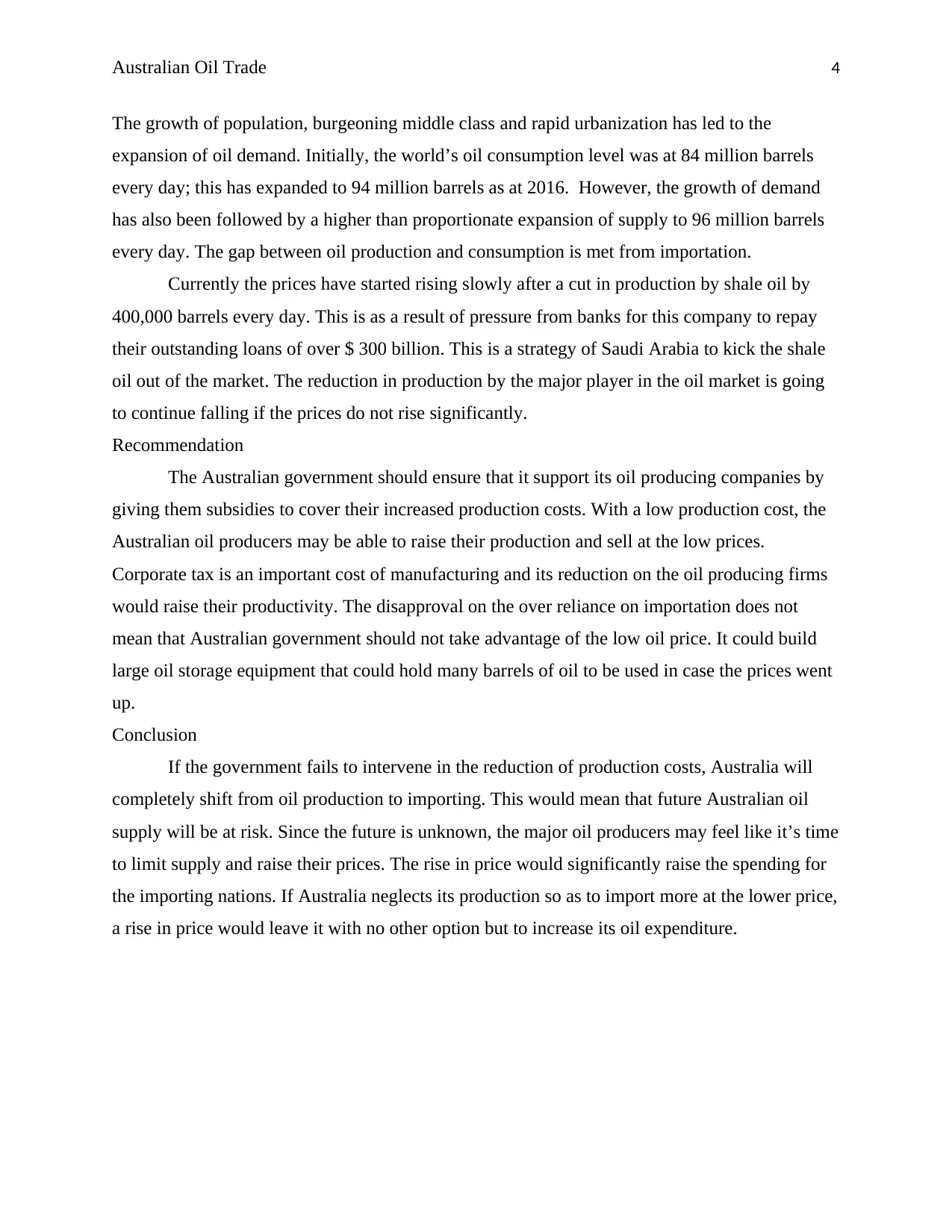
Australian Oil Trade 4
The growth of population, burgeoning middle class and rapid urbanization has led to the
expansion of oil demand. Initially, the world’s oil consumption level was at 84 million barrels
every day; this has expanded to 94 million barrels as at 2016. However, the growth of demand
has also been followed by a higher than proportionate expansion of supply to 96 million barrels
every day. The gap between oil production and consumption is met from importation.
Currently the prices have started rising slowly after a cut in production by shale oil by
400,000 barrels every day. This is as a result of pressure from banks for this company to repay
their outstanding loans of over $ 300 billion. This is a strategy of Saudi Arabia to kick the shale
oil out of the market. The reduction in production by the major player in the oil market is going
to continue falling if the prices do not rise significantly.
Recommendation
The Australian government should ensure that it support its oil producing companies by
giving them subsidies to cover their increased production costs. With a low production cost, the
Australian oil producers may be able to raise their production and sell at the low prices.
Corporate tax is an important cost of manufacturing and its reduction on the oil producing firms
would raise their productivity. The disapproval on the over reliance on importation does not
mean that Australian government should not take advantage of the low oil price. It could build
large oil storage equipment that could hold many barrels of oil to be used in case the prices went
up.
Conclusion
If the government fails to intervene in the reduction of production costs, Australia will
completely shift from oil production to importing. This would mean that future Australian oil
supply will be at risk. Since the future is unknown, the major oil producers may feel like it’s time
to limit supply and raise their prices. The rise in price would significantly raise the spending for
the importing nations. If Australia neglects its production so as to import more at the lower price,
a rise in price would leave it with no other option but to increase its oil expenditure.
The growth of population, burgeoning middle class and rapid urbanization has led to the
expansion of oil demand. Initially, the world’s oil consumption level was at 84 million barrels
every day; this has expanded to 94 million barrels as at 2016. However, the growth of demand
has also been followed by a higher than proportionate expansion of supply to 96 million barrels
every day. The gap between oil production and consumption is met from importation.
Currently the prices have started rising slowly after a cut in production by shale oil by
400,000 barrels every day. This is as a result of pressure from banks for this company to repay
their outstanding loans of over $ 300 billion. This is a strategy of Saudi Arabia to kick the shale
oil out of the market. The reduction in production by the major player in the oil market is going
to continue falling if the prices do not rise significantly.
Recommendation
The Australian government should ensure that it support its oil producing companies by
giving them subsidies to cover their increased production costs. With a low production cost, the
Australian oil producers may be able to raise their production and sell at the low prices.
Corporate tax is an important cost of manufacturing and its reduction on the oil producing firms
would raise their productivity. The disapproval on the over reliance on importation does not
mean that Australian government should not take advantage of the low oil price. It could build
large oil storage equipment that could hold many barrels of oil to be used in case the prices went
up.
Conclusion
If the government fails to intervene in the reduction of production costs, Australia will
completely shift from oil production to importing. This would mean that future Australian oil
supply will be at risk. Since the future is unknown, the major oil producers may feel like it’s time
to limit supply and raise their prices. The rise in price would significantly raise the spending for
the importing nations. If Australia neglects its production so as to import more at the lower price,
a rise in price would leave it with no other option but to increase its oil expenditure.
Paraphrase This Document
Need a fresh take? Get an instant paraphrase of this document with our AI Paraphraser
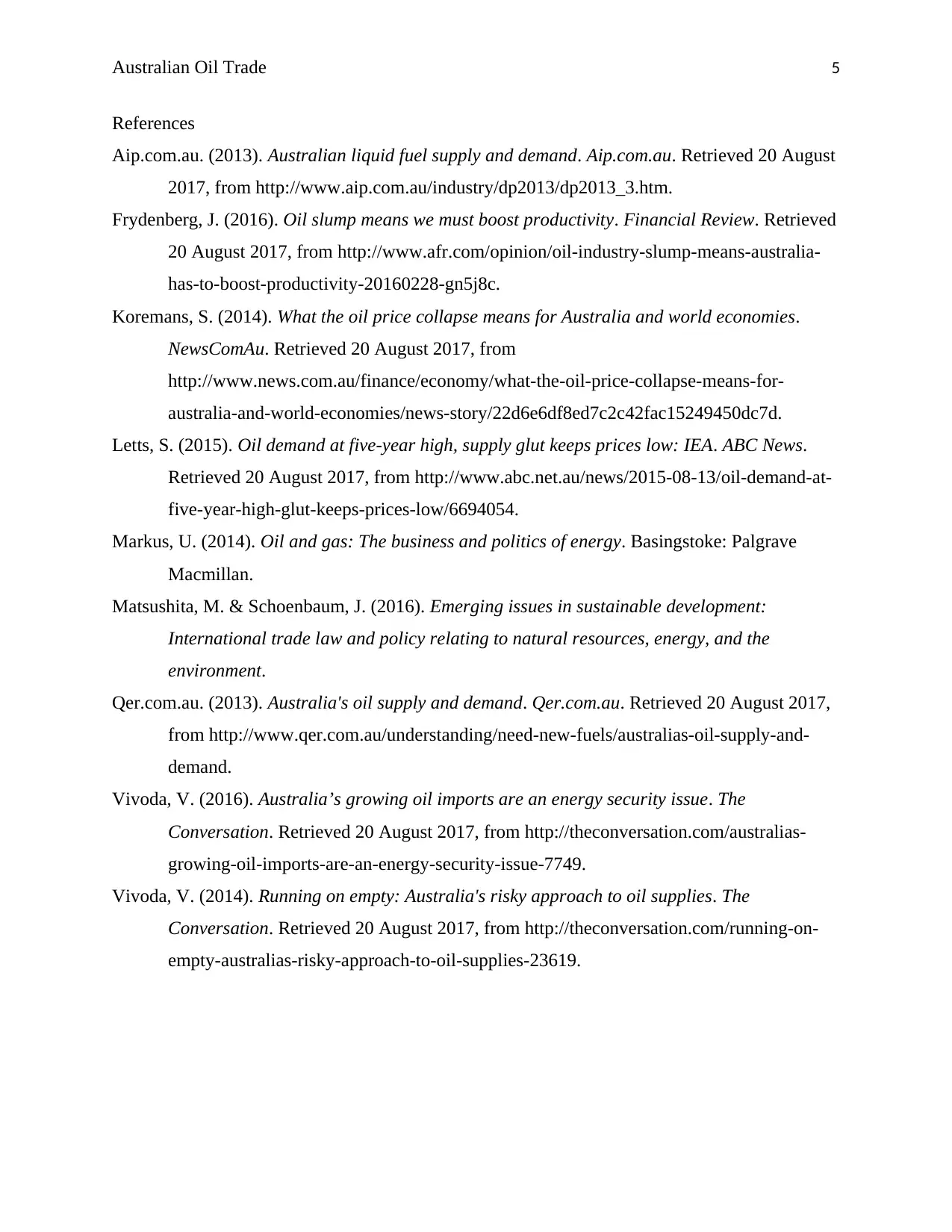
Australian Oil Trade 5
References
Aip.com.au. (2013). Australian liquid fuel supply and demand. Aip.com.au. Retrieved 20 August
2017, from http://www.aip.com.au/industry/dp2013/dp2013_3.htm.
Frydenberg, J. (2016). Oil slump means we must boost productivity. Financial Review. Retrieved
20 August 2017, from http://www.afr.com/opinion/oil-industry-slump-means-australia-
has-to-boost-productivity-20160228-gn5j8c.
Koremans, S. (2014). What the oil price collapse means for Australia and world economies.
NewsComAu. Retrieved 20 August 2017, from
http://www.news.com.au/finance/economy/what-the-oil-price-collapse-means-for-
australia-and-world-economies/news-story/22d6e6df8ed7c2c42fac15249450dc7d.
Letts, S. (2015). Oil demand at five-year high, supply glut keeps prices low: IEA. ABC News.
Retrieved 20 August 2017, from http://www.abc.net.au/news/2015-08-13/oil-demand-at-
five-year-high-glut-keeps-prices-low/6694054.
Markus, U. (2014). Oil and gas: The business and politics of energy. Basingstoke: Palgrave
Macmillan.
Matsushita, M. & Schoenbaum, J. (2016). Emerging issues in sustainable development:
International trade law and policy relating to natural resources, energy, and the
environment.
Qer.com.au. (2013). Australia's oil supply and demand. Qer.com.au. Retrieved 20 August 2017,
from http://www.qer.com.au/understanding/need-new-fuels/australias-oil-supply-and-
demand.
Vivoda, V. (2016). Australia’s growing oil imports are an energy security issue. The
Conversation. Retrieved 20 August 2017, from http://theconversation.com/australias-
growing-oil-imports-are-an-energy-security-issue-7749.
Vivoda, V. (2014). Running on empty: Australia's risky approach to oil supplies. The
Conversation. Retrieved 20 August 2017, from http://theconversation.com/running-on-
empty-australias-risky-approach-to-oil-supplies-23619.
References
Aip.com.au. (2013). Australian liquid fuel supply and demand. Aip.com.au. Retrieved 20 August
2017, from http://www.aip.com.au/industry/dp2013/dp2013_3.htm.
Frydenberg, J. (2016). Oil slump means we must boost productivity. Financial Review. Retrieved
20 August 2017, from http://www.afr.com/opinion/oil-industry-slump-means-australia-
has-to-boost-productivity-20160228-gn5j8c.
Koremans, S. (2014). What the oil price collapse means for Australia and world economies.
NewsComAu. Retrieved 20 August 2017, from
http://www.news.com.au/finance/economy/what-the-oil-price-collapse-means-for-
australia-and-world-economies/news-story/22d6e6df8ed7c2c42fac15249450dc7d.
Letts, S. (2015). Oil demand at five-year high, supply glut keeps prices low: IEA. ABC News.
Retrieved 20 August 2017, from http://www.abc.net.au/news/2015-08-13/oil-demand-at-
five-year-high-glut-keeps-prices-low/6694054.
Markus, U. (2014). Oil and gas: The business and politics of energy. Basingstoke: Palgrave
Macmillan.
Matsushita, M. & Schoenbaum, J. (2016). Emerging issues in sustainable development:
International trade law and policy relating to natural resources, energy, and the
environment.
Qer.com.au. (2013). Australia's oil supply and demand. Qer.com.au. Retrieved 20 August 2017,
from http://www.qer.com.au/understanding/need-new-fuels/australias-oil-supply-and-
demand.
Vivoda, V. (2016). Australia’s growing oil imports are an energy security issue. The
Conversation. Retrieved 20 August 2017, from http://theconversation.com/australias-
growing-oil-imports-are-an-energy-security-issue-7749.
Vivoda, V. (2014). Running on empty: Australia's risky approach to oil supplies. The
Conversation. Retrieved 20 August 2017, from http://theconversation.com/running-on-
empty-australias-risky-approach-to-oil-supplies-23619.

Australian Oil Trade 6
⊘ This is a preview!⊘
Do you want full access?
Subscribe today to unlock all pages.

Trusted by 1+ million students worldwide
1 out of 6
Related Documents
Your All-in-One AI-Powered Toolkit for Academic Success.
+13062052269
info@desklib.com
Available 24*7 on WhatsApp / Email
![[object Object]](/_next/static/media/star-bottom.7253800d.svg)
Unlock your academic potential
Copyright © 2020–2025 A2Z Services. All Rights Reserved. Developed and managed by ZUCOL.





